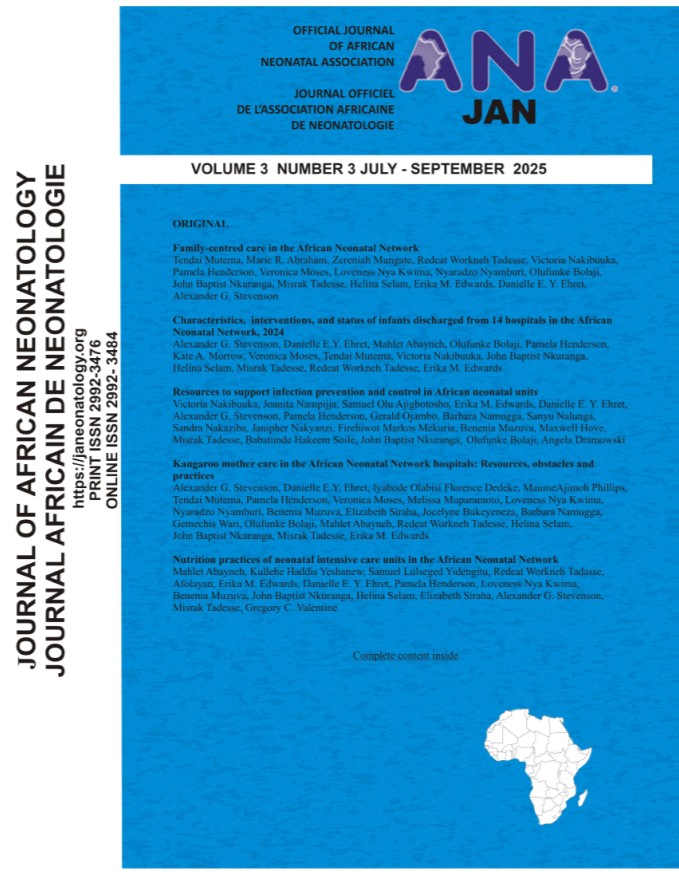Immediate care at birth and neonatal resuscitation in the African Neonatal Network
Keywords:
Infant, Newborn; Infant, Preterm; Resuscitation; Midwifery; Neonatal Nursing; African South of Sahara; Global HealthAbstract
Introduction: Immediate care for the newborn at birth is crucial to prevent neonatal morbidity and mortality from intrapartum related events. These deaths need to be addressed for African nations to achieve targets for Sustainable Development Goal 3.2.
Methods: Fourteen hospitals in the African Neonatal Network responded to an annual facility survey and a health facility survey co - developed by faculty in the African Neonatal Network and Vermont Oxford Network. All analyses use descriptive statistics.
Results: In 10 (71%) of facilities, midwives in the labour and delivery units were most likely to provide routine resuscitation and essential newborn care of both low-risk and high-risk births. Eleven (79%) of 14 hospitals had a guideline or protocol stating that very healthcare worker involved with births should receive neonatal resuscitation training. For the transfer of inborn infants from the delivery room to the neonatal unit, 9 (64%) hospitals reported having 100% oxygen, 8 (57%) CPAP, 6 (43%) continuous pulse oximetry, and 1 (7%) blended oxygen more than 90% of the time. All the hospitals reported consistent availability of equipment for resuscitation like preterm and term masks; however, self- inflating bags were consistently available in 93% of facilities. Equipment for thermoregulation, such as radiant warmers and garments for kangaroo mother care were consistently available in 71% of the facilities.
Conclusions: As ANN units strive to meet SDG 3.2, this study shows that there is room for improvement with regards to the human resources and equipment available for neonatal resuscitation in these facilities.
References
Hillman N, Kallapur SG, Jobe A. Physiology of transition from intrauterine to extrauterine life. Clin Perinatol. 2012 Dec;39(4):769–83.
Singhal N, Bhutta ZA. Newborn resuscitation in resource limited settings. Seminars in Fetal and Neonatal Medicine. 2008 Dec 1;13(6):432–9.
Lawn JE, Manandhar A, Haws RA, Darmstadt GL. Reducing one million child deaths from birth asphyxia – a survey of health systems gaps and priorities. Health Res Policy Syst. 2007 May 16;5:4.
Dol J, Hughes B, Bonet M, Dorey R, Dorling J, Grant A, et al. Timing of neonatal mortality and severe morbidity during the postnatal period: a systematic review. JBI Evidence Synthesis. 2023 Jan;21(1):98–199.
Berkelhamer SK, Kamath- Rayne BD, Niermeyer S. Neonatal resuscitation in lowresource settings. Clin Perinatol. 2016 Sep;43(3):573–91.
Lawn JE, Lee AC, Kinney M, Sibley L, Carlo WA, Paul VK, et al. Two million intrapartumrelated stillbirths and neonatal deaths: Where, why, and what can be done? Int J Gynaecol Obstet. 2009 Oct;107:S5–19.
Wall SN, Lee AC, Niermeyer S, English M, Keenan WJ, Carlo W, et al. Neonatal resuscitation in low-resource settings: What, who, and how to overcome challenges to scale up? Int J Gynaecol Obstet. 2009 Oct;107:S47–64.
Niermeyer S. From the Neonatal Resuscitation Program to Helping Babies Breathe: Global impact of educational programs in neonatal resuscitation. Semin Fetal Neonatal Med. 2015 Oct;20(5):300–8.
Lee ACC, Cousens S, Wall SN, Niermeyer S, Darmstadt GL, Carlo WA, Keenan WJ, Bhutta ZA, Gill C, Lawn JE. Neonatal resuscitation and immediate newborn assessment and stimulation for the prevention of neonatal deaths: a systematic review, metaanalysis and Delphi estimation of mortality effect. BMC Public Health. 2011 Apr;11(Suppl 3):S12.
Nimbalkar AS, Shukla VV, Phatak AG, Nimbalkar SM. Newborn care practices and health seeking behavior in urban slums and villages of Anand, Gujarat. Indian Pediatr. 2013 Apr;50(4):408–10.
Enweronu-Laryea C, Dickson KE, Moxon SG, Simen-Kapeu A, Nyange C, Niermeyer S, Begin F, Sobel HL, Lee ACC, von Xylander S, Lawn JE. Basic newborn care and neonatal resuscitation: a multicountry analysis of health system bottlenecks and potential solutions. BMC Pregnancy Childbirth. 2015;15 Suppl 2(Suppl 2):S4.
Eyeberu A, Yadeta E, Mezmur H, Motuma A, Debella A. Neonatal resuscitation skill among health care providers in Eastern Africa: A systematic review and meta-analysis. Global Pediatr. 2025 Mar 1;11:100248.
Disu EA, Ferguson IC, Njokanma OF, Anga LA, Solarin AU, Olutekunbi AO, Ekure EN, Ezeaka VC, Esangbedo DO, Ogunlesi TA. National neonatal resuscitation training program in Nigeria (2008- 2012): A preliminary report. Niger J Clin Pract. 2015 Feb;18(1):102.
Dunn MS, Kaempf J, de Klerk A, de Klerk R, Reilly M, Howard D, Ferrelli K, O’Conor J, Soll RF; Vermont Oxford Network DRM Study Group. Randomized trial comparing 3 approaches to the initial respiratory management of preterm neonates. Pediatr. 2011 Nov;128(5):e1069-1076.
Kirpalani H, Nelin L, Abman SH. Extending nasal continuous positive airway pressure for preterm infants: new targets for an old device. Am J Respir Crit Care Med. 2025 Apr;211(4):550–1.
Lunze K, Hamer DH. Thermal protection of the newborn in resource-limited environments. J Perinatol. 2012 May;32(5):317–24.
Mullany LC. Neonatal hypothermia in low-resource settings. Semin Perinatol. 2010 Dec 1;34(6):426–33.
Downloads
Published
Issue
Section
License
Copyright (c) 2025 JOURNAL OF AFRICAN NEONATOLOGY

This work is licensed under a Creative Commons Attribution-NonCommercial-ShareAlike 4.0 International License.
This is an open-access journal, and articles are distributed under the terms of the Creative Commons Attribution-NonCommercial-ShareAlike 4.0 License, which allows others to remix, tweak, and build upon the work non-commercially, as long as appropriate credit is given and the new creations are licensed under the identical terms.

